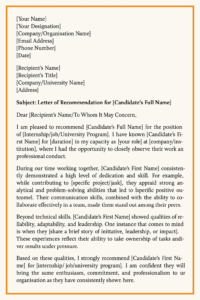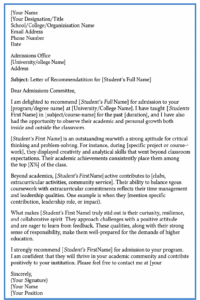
Letter of Recommendation Format: Correct Format, Importance, Sample Letters
A standard letter of recommendation format typically includes your professional letterhead, contact information, the date, and the recipient’s address. A letter of recommendation can significantly influence someone’s professional or academic journey. Whether you are applying for a job, an internship, or higher education, the way your recommender structures this letter plays a crucial role. That’s where understanding the letter of recommendation format becomes so important.
Continue reading the article to understand why it is important to adhere to the correct letter of recommendation format. Also, learn how to write LOR in the correct format along with some sample templates.
What is a Letter of Recommendation?
A letter of recommendation (often abbreviated as LOR) is a written document in which a person in a position of authority endorses someone for a specific opportunity, such as a job, internship, scholarship, or academic program. The recommender vouches for the candidateʼs skills, character, and overall suitability.
It is not a generic reference but rather a customised document tailored to a specific role or institution. For example, a letter of recommendation for job applications may highlight professional achievements and work ethic, while a letter of recommendation for an internship could focus on learning potential, academic strengths, and adaptability.
Why is Knowing the Correct Letter of Recommendation Format Important?
The letter of recommendation format ensures the document looks professional, credible, and easy to read. A poorly formatted letter may risk being disregarded, no matter how glowing the content is.
Hereʼs why formatting matters:
- Professionalism: Employers and universities expect a certain structure; deviating from it can look unprofessional.
- Clarity: A structured document makes it easy for committees or hiring managers to grasp key points quickly.
- Impact: A logical format highlights your strongest traits clearly rather than burying them in walls of text.
A letter of recommendation is not always mandatory, but when it is, the formatting makes the difference between a persuasive and a weak recommendation.
If you’re applying to a university, this step-by-step guide on how to write an SOP can help.
What is the Correct Letter of Recommendation Format?
While the design may vary slightly depending on whether itʼs for work, academic, or internship purposes, the core letter of recommendation format remains consistent.
The table below shows the correct letter of recommendation format in the correct sequence from the start to the end.
| Section | What to include | Example |
| Header & Contact Info | Recommender’s name, title, organisation, contact details, date, recipient’s info | John Smith, Professor, XYZ University, john@xyz.edu |
| Salutation or Greeting | Address the recipient or use “To Whom It May Concern” | Dear Admissions Committee |
| Introduction | Who you are, your relationship with the candidate | “I taught Stanley in Computer Science for 2 years…” |
| Body Paragraph(s) | Candidate’s achievements, skills, qualities, examples | “He led a group project that won the X award…” |
| Conclusion & Endorsement | Strong statement of recommendation | “I strongly recommend Stanley for your program.” |
| Closing & Signature | Professional closing, handwritten/digital signature | “Sincerely, Prof. John Smith” |
How to Write a Letter of Recommendation in the Right Format?
Writing a compelling LOR goes beyond simply filling in the letter of recommendation format. It needs warmth, authenticity, and specificity. Hereʼs a step-by-step guide:
- Understand the Purpose
- The recommender should be informed whether the letter is for a university application, internship, or job position. Your tone and examples should match the purpose of the letter of recommendation.
- Brainstorm Relevant Qualities
- List the candidateʼs academic achievements, professional work, and personal qualities relevant to the opportunity.
- Follow the Format Neatly
- Use a professional font (Times New Roman, Calibri, Arial).
- Maintain 1-inch margins and single spacing.
- Keep it to one page 300-400 words).
- Personalise the Content
- Replace generic praise with specific results.
- “She is hardworking.”
- “During our project, she improved team efficiency by 25%.”
- Proofread Carefully
- Avoid errors that could harm credibility.
What Are the Different Types of Letter of Recommendation Formats?
There are two main types of LORs:
- Academic
- Professional
Academic LOR
An academic LOR format is used when applying to colleges, graduate schools, or scholarships. It highlights a student’s intellectual abilities, academic achievements, and potential for future success.
This type of letter is usually written by teachers, professors, or academic advisors who know the student in a classroom or research setting. The format typically includes:
- Introduction: Who the recommender is, their role, and how long they have known the student.
- Body Paragraphs: Examples of academic strengths such as analytical skills, creativity, research aptitude, or problem-solving. It may also cover leadership in academic clubs, participation in research projects, or unique classroom contributions.
- Conclusion: A strong recommendation that explains why the student would be a good fit for the institution or program.
The tone of an academic LOR is formal, evidence-based, and focused on academic growth.
Professional LOR
A professional LOR format is used when applying for jobs, internships, or professional training programs. Instead of focusing on academics, it emphasises the candidate’s work ethic, practical skills, and career potential.
This type of recommendation is usually written by managers, supervisors, or colleagues who have worked with the candidate in a professional setting. The structure generally follows:
- Introduction: The professional relationship (for example, “I supervised [Name] for six months on [Project]”).
- Body Paragraphs: Specific examples of professional skills such as time management, teamwork, leadership, technical expertise, or problem-solving. Including measurable results (e.g., “helped increase sales by 20%”) makes the letter stronger.
- Conclusion: A summary of the candidate’s strengths and a clear endorsement that they would bring value to the company or organisation.
The tone of a professional LOR is practical, results-oriented, and career-focused.
Sample Letters of Recommendation (LOR Templates)
Nothing explains the letter of recommendation format better than seeing real-world examples. Below are sample templates you can adapt.
Sample Academic Letter of Recommendation for Internships & Jobs

Also read: Academic LOR Sample — BS in Computer Science
Sample Professional Letter of Recommendation for College or University Applications

Also read: Professional LOR Sample — MBA in Data Analytics
What Mistakes to Avoid in a Letter of Recommendation?
Even if the letter of recommendation format is correct, some mistakes can undermine its effectiveness:
- Using vague, generic praises without concrete examples.
- Making the letter too short (less than one paragraph) or too long (over two pages).
- Writing in an overly casual or unprofessional tone.
- Leaving out a signature raises doubts about authenticity.
- Copy-pasting templates without customisation.
Key Takeaways on Letter of Recommendation Format
- A letter of recommendation format includes a header, introduction, body paragraphs, conclusion, and signature.
- Tailor the letter to the purpose, such as an internship, job, or academic program.
- Authenticity and personalisation are as important as structure.
- Avoid vague praises; provide specific examples.
- Keep it 1 page, 300–400 words.
- A signed letter is always more credible
FAQs about Letter of Recommendation Format
Q1. How many letter of recommendation do you need?
A1. It depends. Universities may ask for 23, jobs typically need 1-2, while internships often require just one.
Q2. How long is a letter of recommendation valid?
A2. While not legally expired, a letter older than 6 12 months may appear outdated. A fresh letter is always better.
Q3. Is letter of recommendation important?
A3. Yes, it provides third-party validation of your credibility. It can be the deciding factor between two equally qualified candidates.
Q4. Is letter of recommendation mandatory?
A4. Not always. Some jobs may prefer it, while academic programs almost always require it.
Q5. Does letter of recommendation need to be signed?
A5. Yes, a signature gives authenticity. The signature can be handwritten or digital.
Q6. Can letter of recommendation be from anyone?
A6. No. It should be from someone credible, such as professors, employers, or supervisors who know your work well.

